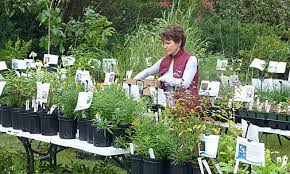Native Plant Sales: Supporting Biodiversity and Creating Sustainable Landscapes
Native plant sales have become increasingly popular in recent years as more people recognize the importance of incorporating native species into their landscapes. These events provide an opportunity for individuals, gardeners, and conservationists to access a wide variety of native plants that are specifically adapted to local ecosystems.
But what exactly are native plants, and why should we consider using them in our gardens and landscapes? Native plants are those that occur naturally in a particular region and have co-evolved with local wildlife over thousands of years. They provide essential habitat, food sources, and shelter for a wide range of insects, birds, butterflies, and other wildlife.
One of the primary benefits of using native plants is their ability to support biodiversity. By planting native species, we can create habitats that attract and sustain a diverse array of wildlife. Native plants often require less water, fertilizer, and pesticides compared to non-native species since they have evolved to thrive in local conditions. This makes them an environmentally friendly choice for sustainable landscaping.
Native plant sales offer an excellent opportunity for individuals to learn about different species and their ecological significance. These events are often organized by local conservation organizations, botanical gardens, or nurseries specializing in native plants. They bring together experts who can provide guidance on selecting appropriate species for specific soil types, light conditions, or desired landscape aesthetics.
When attending a native plant sale, it’s important to be prepared by doing some research beforehand. Consider the specific needs of your garden or landscape area – such as sun exposure or soil type – as this will help you choose the right plants for your site. Additionally, take note of any local regulations or restrictions on planting certain invasive species that may be sold at the event.
By purchasing native plants at these sales, you are not only enhancing your own garden but also supporting local conservation efforts. Many organizations use the proceeds from these sales to fund important projects such as habitat restoration, educational programs, or the preservation of endangered species.
Native plant sales also provide an opportunity for community engagement and networking. You can connect with like-minded individuals who share an interest in sustainable gardening and conservation. These events often include workshops, presentations, or demonstrations on topics such as plant care, wildlife gardening, or ecological landscaping practices.
Furthermore, by incorporating native plants into our landscapes, we can contribute to the larger goal of conserving biodiversity and protecting our natural heritage. Native plants play a crucial role in maintaining healthy ecosystems by providing food and shelter for pollinators, birds, and other wildlife. They also help mitigate the effects of climate change by sequestering carbon dioxide and reducing stormwater runoff.
In conclusion, native plant sales offer a valuable opportunity to support biodiversity conservation while creating beautiful and sustainable landscapes. By choosing native species, we can reduce our environmental footprint and enhance the ecological value of our gardens. So why not join your local community at the next native plant sale? Together, we can make a difference in preserving our natural heritage for future generations.
Understanding Native Plants: Definition and Benefits
What is the definition of a native plant?
A native plant is a species of plant that occurs naturally in a particular region, ecosystem, or habitat and has evolved and adapted to the local environmental conditions over a long period of time. These plants have established themselves in specific geographic areas without human intervention. They are well-suited to the climate, soil types, and other ecological factors of their native region.
Native plants play an essential role in maintaining the balance and functionality of local ecosystems. They have developed complex relationships with native wildlife, including insects, birds, mammals, and other organisms. These relationships often involve mutual dependencies for food, shelter, pollination, seed dispersal, and other ecological services.
The use of native plants in landscaping and gardening is encouraged because they are well-adapted to the local environment. They generally require less water, fertilizer, and pesticides compared to non-native species since they have evolved to thrive under natural conditions. By using native plants in our landscapes, we can support biodiversity conservation efforts by providing habitat for native wildlife and promoting ecological resilience.
It’s important to note that the definition of a native plant can vary depending on the context or geographic region being referred to. For example, a plant may be considered native in one area but invasive or non-native in another if it was introduced from elsewhere and disrupts local ecosystems.
What are 3 benefits of native plants?
Biodiversity Support: Native plants have evolved over time to coexist with local wildlife, making them an essential part of the ecosystem. By planting native species, we provide food and habitat for a wide range of insects, birds, butterflies, and other wildlife. This promotes biodiversity and helps maintain a healthy and balanced ecosystem.
Environmental Sustainability: Native plants are well-adapted to local climate conditions, requiring less water, fertilizer, and pesticides compared to non-native species. Their deep root systems help prevent soil erosion and improve water infiltration, reducing the need for irrigation. By using native plants in our landscapes, we can conserve water resources and minimize the use of harmful chemicals, making our gardens more environmentally sustainable.
3. Ecosystem Resilience: Native plants play a crucial role in maintaining the resilience of ecosystems. They provide stability to natural areas by preventing invasive species from taking over and outcompeting native vegetation. Native plant communities also support the health of soil organisms and contribute to nutrient cycling processes. By incorporating native plants into our landscapes, we help preserve the integrity of local ecosystems and contribute to their long-term health and sustainability.

